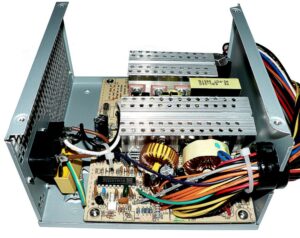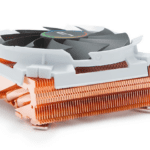The Changing Face of ATX Power Supplies (ATX12v1.x – ATX3.0)
First introduced in 1995, the ATX power supply standard has undergone regular revisions and updates to meet the growing power demands of each new generation of PC components. Understanding this evolution helps illustrate how power requirements have increased exponentially alongside processing power and capabilities.

Contents
In the Beginning, There Was ATX
The original ATX standard defined three types of connectors to power motherboards, drives and other peripherals—a 20-pin motherboard connector, 4-pin floppy and Molex drive connectors, and a supplemental 6-pin AUX connector. Most power output was delivered along 5V and 3.3V rails, while 12V rails only powered fans and motors.
ATX12V 1.0 Arrives for the Pentium 4
When designing the power-hungry Pentium 4 in 2000, the 20-pin ATX connector proved insufficient. ATX12V 1.0 markedly increased 12V rail amperage and introduced a 4-pin supplementary 12V connector dedicated to the CPU. This enabled suitable power delivery to the first processors needing DC-to-DC conversion to step down voltage right on the motherboard, starting a trend.
Revisions Add Minor Tweaks
Over 2000-2003, ATX12V 1.1 through 1.3 tweaked and built upon the standard, increasing efficiency percentages, better defining acoustic levels and introducing the first Serial ATA power cables. Support also formally ended for legacy -5V rails required only by obsolete ISA expansion cards.
ATX12V 2.0 Shifts Priority to 12V Rails
Analyzing modern PC power needs precipitated a more radical rethinking of supply design in 2003’s ATX12V 2.0. With AGP cards already drawing more juice from 12V lines than legacy 3.3V/5V rails, and CPU and PCI Express power also requiring 12V conversion, the bulk of power delivery shifted onto the 12V rails with lower 5V/3.3V output. This allowed smaller, more efficient PSUs. The 24-pin motherboard connector and mandatory SATA cables also debuted.
Further Revisions Tweak Efficiency
Until 2007’s ATX12V 2.3, subsequent 2.x revisions made largely incremental improvements, increasing minimum efficiency levels to meet stricter regulations and adding specification clarifications. Later 2.31 and 2.32 updates continued this trend into the 2010s, formally supporting modern standby modes.
ATX 3.0 Brings Intelligent Power Delivery
After over 15 years, 2022 witnessed the debut of ATX 3.0, headlined by introducing 16-pin “12VHPWR” PCIe Gen 5 graphics connectors capable of delivering an staggering 600 watts at up to 50 amps for top GPUs. Intelligent components can now communicate directly with supplies to negotiate optimum power delivery levels too. Strict new transient spike and efficiency requirements also ensurestability.
The Never-Ending Quest for More Power
From humble 20-pin ATX origins to today’s cutting-edge ATX 3.0 standard with dynamic 600W graphics power delivery, improving power supplies remain crucial in pushing PC performance boundaries. So as tomorrow’s components demand ever more peak wattage, we can expect further PSU innovations still to come. The electrifying quest for speed has no end in sight!




